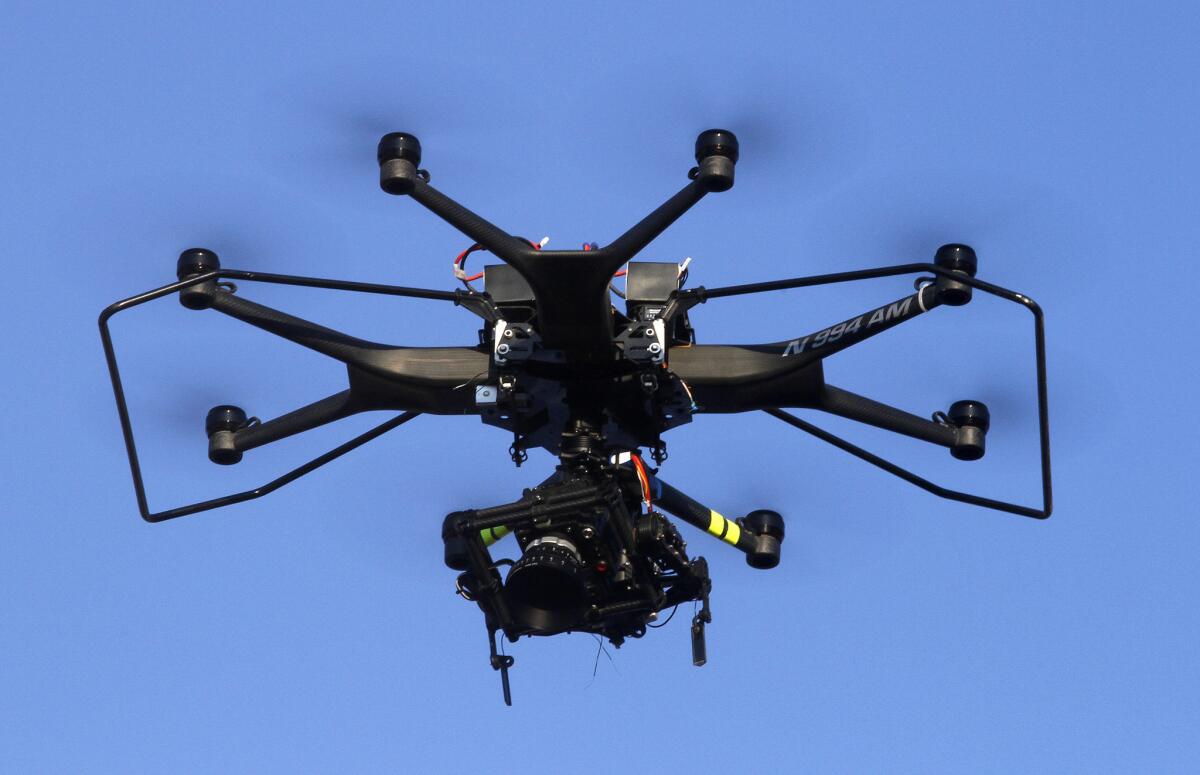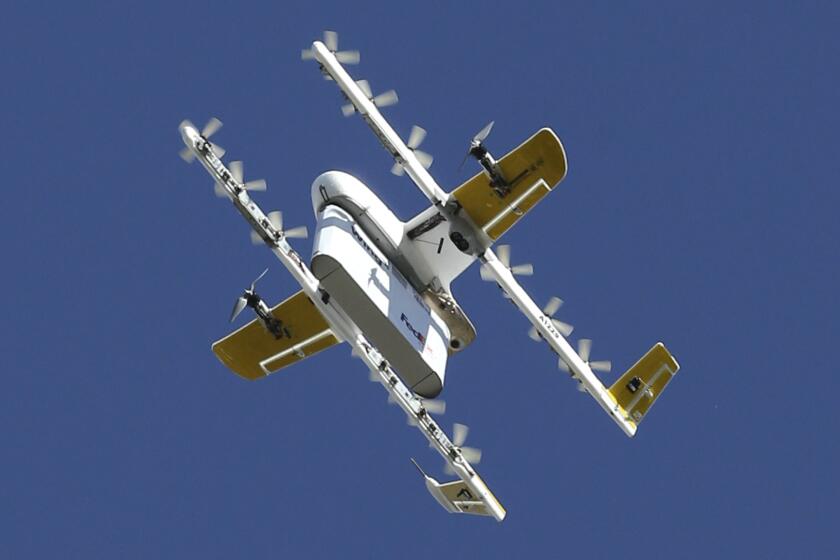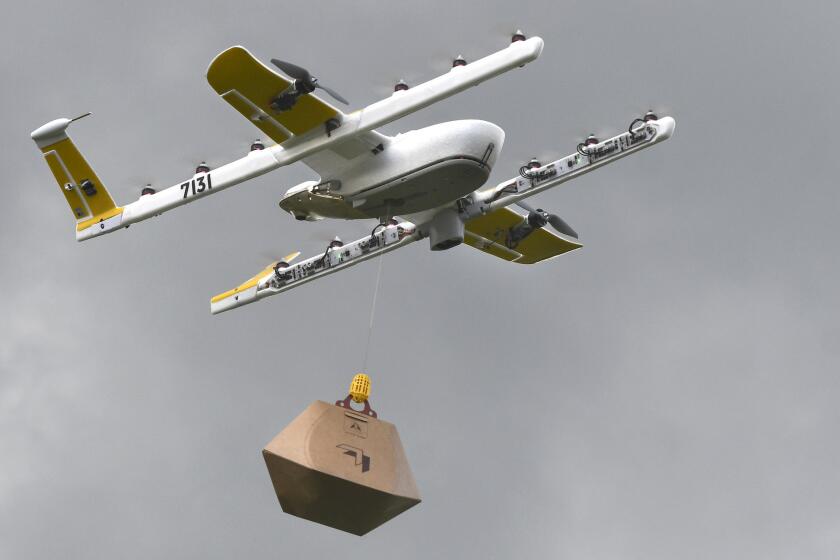Drones need a huge tracking network, FAA says

- Share via
All but the smallest civilian drones would have to broadcast radio tracking data, under a sweeping proposal unveiled Thursday by U.S. regulators seeking to ensure greater safety and prevent terrorism.
The long-awaited draft rules call for a massive new tracking network for everything from toys to larger commercial drones so that law enforcement can spot the devices flying anywhere, in congested urban areas as well as the most rural zones.
The controversial measure by the Federal Aviation Administration, which is subject to public comment and could change before it becomes final, is a key foundation to advance drone-driven commerce, including deliveries of consumer goods by companies such as Alphabet Inc.’s Wing and Amazon.com Inc.’s Prime Air. The rules would come into full force three years after being finalized.
“Remote ID technologies will enhance safety and security by allowing the FAA, law enforcement and federal security agencies to identify drones flying in their jurisdiction,” Transportation Secretary Elaine Chao said in a statement.
With only limited exceptions for groups such as model-airplane operators, all drones weighing more than 0.55 pounds would have to broadcast their position and operator’s identity at all times under the FAA proposal.
The FAA is suggesting that private companies approved by the agency would set up tracking systems for drones, replicating the existing air-traffic control system for traditional aircraft.
Law enforcement and homeland security agencies had demanded a tracking mandate in response to the growing number of drone threats, including a handful of close calls that halted airline flights near airports, collisions with other aircraft or use of the devices by terrorists around the world.
The FAA is trying to finalize the regulation as soon as possible, said Brandon Roberts, the agency’s acting director of rulemaking. An earlier proposal by the FAA to allow drone flights over people has been held up until a tracking system can be developed.
Google sibling Wing just launched commercial drone delivery in the U.S., and other companies are pursuing it. Questions about privacy, noise and liability still need to be answered.
The issue has fractured the rapidly growing base of drone operators, at times pitting recreational fliers and different segments of the industry against one another even as the majority of users acknowledge the need for some type of tracking. It also has raised significant concerns about government monitoring of the public.
Under the FAA proposal, if drone operators want to operate freely, they would have to broadcast their identity on a radio frequency that can be monitored nearby and simultaneously upload the information via the internet.
That way, nearby drones and aircraft could steer clear, and local police equipped with tracking devices could identify rogue operators. At the same time, the devices also could be monitored from a remote, central system.
Drone users could choose a more limited option of uploading the information to the internet only, but they would be restricted to flying within 400 feet of the operator.
The agency is proposing that the rules would take effect three years after they’re finalized, meaning routine delivery flights and other commercial operations wouldn’t be possible until at least then.
Transportation is responsible for 29% of U.S. greenhouse gas emissions. Drones delivering packages could help reduce that — depending on how and where they’re deployed.
The U.S. Chamber of Commerce believes the proposed rule on remote identification of drones “will help ensure the safety and security of the airspace and enable more innovative applications and uses of unmanned aircraft systems such as package delivery and long-range surveying,” said Tim Day, senior vice president for the group’s Technology Engagement Center.
Existing drones wouldn’t have to install tracking equipment retroactively, but in most cases they would be banned from operation after the rule becomes law. Starting two years after the regulation takes effect, new unmanned devices sold would have to have approved tamper-resistant tracking devices.
The costs on the public and the drone industry for the proposed regulation would be an estimated $584 million over 10 years. Some drones may be able to comply with just a software change, so those owners may not have to pay anything, the FAA said.
The proposal would create exemptions designed for traditional model-aircraft operators, who have been flying at designated sites for decades without posing a safety hazard.
Because there is no current method of reliably tracking the devices, existing regulations typically require civilian hobbyists and commercial operators to keep their drones within 400 feet of the ground and within their sight. Better tracking would not only allow drones to fly safely over far larger areas, it could also enable a robotic system enabling drones to sense one another and avoid collisions.
The Assn. for Unmanned Vehicle Systems International, an industry trade group, applauded the FAA for moving forward on the repeatedly delayed proposal. “The importance of remote ID regulations cannot be overstated, as they are necessary to enable advanced and expanded operations,” said Brian Wynne, the group’s president.
The Academy of Model Aeronautics, which represents model aircraft buffs, has argued that its members should be at least partly exempt because they have their own system of identification.
SZ DJI Technology Co., the world’s largest civilian drone manufacturer, has touted its own proprietary tracking system, but whether it would meet the proposed standards is unclear. The company is still reviewing the proposal, said Brendan Schulman, vice president of policy and legal affairs.
“We will be guided by the principle, recognized by the FAA’s own Aviation Rulemaking Committee in 2017, that remote identification will not be successful if the burdens and costs to drone operators are not minimized,” Schulman said in an emailed statement.
By contrast, Wing and Amazon want a more formalized technology that can track drones in real time across the nation, similar to how radar systems keep tabs on jetliners. Such a system is needed to maintain order in skies crowded with drones, they say.
The rapid growth in drone use has been a challenge for regulators. More than 1 million people and businesses have registered with the FAA as drone owners, and the agency estimates there are 1.3 million of the devices in the United States.
Through June, the FAA has received more than 8,700 reports of drones flying in prohibited areas or in an unsafe manner. There are typically more than 200 such incidents a month when the weather is warmer, according to FAA data.
Although most incidents are relatively minor, the large numbers indicate that at least some drone users are ignoring the rules. Catching such perpetrators has proved all but impossible.
The National Transportation Safety Board has confirmed at least two collisions between a drone and a traditional aircraft: a U.S. Army helicopter hit a small civilian drone near New York City in September 2017, and a small drone grazed a hot-air balloon in Idaho in August 2018.
The agency is investigating whether a drone struck a TV station’s helicopter flying over Los Angeles on Dec. 4. An object hit the helicopter, damaging areas near its tail.
Another fear is the growing use of drones as terrorist weapons. FBI Director Christopher Wray told lawmakers last year that drones pose a “steadily escalating” threat.
Saudi Arabian officials alleged that drones were used to attack that country’s oil fields Sept. 14, though they were far larger than the typical civilian drone. Explosive-laden drones were used in an unsuccessful assassination attempt against Venezuela President Nicolas Maduro last year.
Levin writes for Bloomberg.








